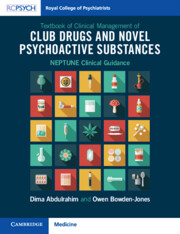 Textbook of Clinical Management of Club Drugs and Novel Psychoactive Substances
Textbook of Clinical Management of Club Drugs and Novel Psychoactive Substances Book contents
- Textbook of Clinical Management of Club Drugs and Novel Psychoactive Substances
- Textbook of Clinical Management of Club Drugs and Novel Psychoactive Substances
- Copyright page
- Contents
- Acknowledgements
- Part I Introduction and Background
- Part II Drugs with Primarily Depressant Effects
- Chapter 3 Gamma-Hydroxybutyrate (GHB) and Gamma-Butyrolactone (GBL)
- Chapter 4 New Benzodiazepine Novel Psychoactive Substances
- Chapter 5 Synthetic Opioid Novel Psychoactive Substances (Fentanyl and Non-fentanyl)
- Chapter 6 Ketamine and Other Novel Psychoactive Substances with Dissociative Effects
- Chapter 7 Nitrous Oxide (N2O)
- Part III Drugs with Primarily Stimulant Effects
- Part IV Drugs with Primarily Hallucinogenic Effects
- Part V Synthetic Cannabinoid Receptor Agonists
- Part VI Concluding Remarks
- Index
- References
Chapter 6 - Ketamine and Other Novel Psychoactive Substances with Dissociative Effects
from Part II - Drugs with Primarily Depressant Effects
Published online by Cambridge University Press: 06 October 2022
- Textbook of Clinical Management of Club Drugs and Novel Psychoactive Substances
- Textbook of Clinical Management of Club Drugs and Novel Psychoactive Substances
- Copyright page
- Contents
- Acknowledgements
- Part I Introduction and Background
- Part II Drugs with Primarily Depressant Effects
- Chapter 3 Gamma-Hydroxybutyrate (GHB) and Gamma-Butyrolactone (GBL)
- Chapter 4 New Benzodiazepine Novel Psychoactive Substances
- Chapter 5 Synthetic Opioid Novel Psychoactive Substances (Fentanyl and Non-fentanyl)
- Chapter 6 Ketamine and Other Novel Psychoactive Substances with Dissociative Effects
- Chapter 7 Nitrous Oxide (N2O)
- Part III Drugs with Primarily Stimulant Effects
- Part IV Drugs with Primarily Hallucinogenic Effects
- Part V Synthetic Cannabinoid Receptor Agonists
- Part VI Concluding Remarks
- Index
- References
Summary
Dissociative drugs distort perceptions of sight and sound and produce feelings of detachment (or dissociation) from the environment and self. Among the dissociative drugs, ketamine and phencyclidine (PCP) are the drugs most commonly used for recreational purposes.
- Type
- Chapter
- Information
- Textbook of Clinical Management of Club Drugs and Novel Psychoactive SubstancesNEPTUNE Clinical Guidance, pp. 101 - 130Publisher: Cambridge University PressPrint publication year: 2022
